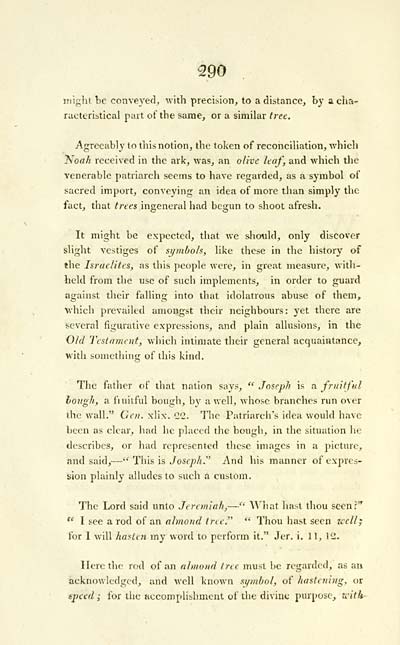Blair Collection > Celtic researches, on the origin, traditions & language, of the ancient Britons
(382)
Download files
Complete book:
Individual page:
Thumbnail gallery: Grid view | List view

290
îniglil be conveyed^ with precision, to a distance, by a cha-
racteristical part of the same, or a similar tree.
Agreeably to this notion, the token of reconciliation, Λν1ιΐ€ΐι
ìsoah received in the ark, was, an olive leaf, and Avhich the
venerable patriarch seems to have regarded, as a symbol of
sacred import, conveying an idea of more than simply the
fact, that tnes ingeneral had begun to shoot afresh.
It might be expected, that we shovld, only discover
slight vestiges of symbols, like these in the history of
the Israelites, as this people were, in great measure, with-
held from the use of such implements, in order to guard
against their falling into that idolatrous abuse of them,
which prevailed amongst their neighbours: yet there are
several figurative expressions, and plain allusions, in the
Old Testament, which intimate their general acquaintance,
with something of this kind.
The father of that nation says, *' Joseph is a fruitful
bough, a fiuitful bough, by a well, whose branches run over
the wall." Geu. xlix. GC. The Patriarch's idea would have
been as clear, had he placed the bough, in the situation he
describes, or had represented these images in a picture,
and said, — " This is Joseph." And his manner of expres-
sion plainly alludes to such a custom.
The Lord said unto Jeremiah, — "■ What ha>t thou seen:''
'' I see a rod of an almoud free." " Thou hast seen ziell;
for I will hasten my word to perform it." Jer. i. II, 111.
Here the rod of an almond free must be regarded, as an
acknowledged, and well known symbol, of hastening, or
6pce<l ; for the ucconiplisliment of the divine purpose, with
îniglil be conveyed^ with precision, to a distance, by a cha-
racteristical part of the same, or a similar tree.
Agreeably to this notion, the token of reconciliation, Λν1ιΐ€ΐι
ìsoah received in the ark, was, an olive leaf, and Avhich the
venerable patriarch seems to have regarded, as a symbol of
sacred import, conveying an idea of more than simply the
fact, that tnes ingeneral had begun to shoot afresh.
It might be expected, that we shovld, only discover
slight vestiges of symbols, like these in the history of
the Israelites, as this people were, in great measure, with-
held from the use of such implements, in order to guard
against their falling into that idolatrous abuse of them,
which prevailed amongst their neighbours: yet there are
several figurative expressions, and plain allusions, in the
Old Testament, which intimate their general acquaintance,
with something of this kind.
The father of that nation says, *' Joseph is a fruitful
bough, a fiuitful bough, by a well, whose branches run over
the wall." Geu. xlix. GC. The Patriarch's idea would have
been as clear, had he placed the bough, in the situation he
describes, or had represented these images in a picture,
and said, — " This is Joseph." And his manner of expres-
sion plainly alludes to such a custom.
The Lord said unto Jeremiah, — "■ What ha>t thou seen:''
'' I see a rod of an almoud free." " Thou hast seen ziell;
for I will hasten my word to perform it." Jer. i. II, 111.
Here the rod of an almond free must be regarded, as an
acknowledged, and well known symbol, of hastening, or
6pce<l ; for the ucconiplisliment of the divine purpose, with
Set display mode to: Large image | Transcription
Images and transcriptions on this page, including medium image downloads, may be used under the Creative Commons Attribution 4.0 International Licence unless otherwise stated. ![]()
| Early Gaelic Book Collections > Blair Collection > Celtic researches, on the origin, traditions & language, of the ancient Britons > (382) |
|---|
| Permanent URL | https://digital.nls.uk/75768097 |
|---|
| Description | A selection of books from a collection of more than 500 titles, mostly on religious and literary topics. Also includes some material dealing with other Celtic languages and societies. Collection created towards the end of the 19th century by Lady Evelyn Stewart Murray. |
|---|
| Description | Selected items from five 'Special and Named Printed Collections'. Includes books in Gaelic and other Celtic languages, works about the Gaels, their languages, literature, culture and history. |
|---|

